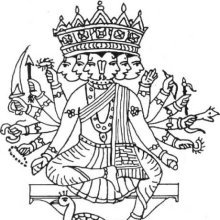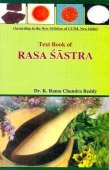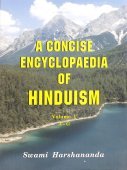Caturmukha, Catur-mukha, Caturmukhā: 24 definitions
Introduction:
Caturmukha means something in Buddhism, Pali, Hinduism, Sanskrit, Jainism, Prakrit. If you want to know the exact meaning, history, etymology or English translation of this term then check out the descriptions on this page. Add your comment or reference to a book if you want to contribute to this summary article.
Alternative spellings of this word include Chaturmukha.
Images (photo gallery)
In Hinduism
Vastushastra (architecture)
Source: Wisdom Library: Vāstu-śāstra1) Caturmukha (चतुर्मुख):—One of the eight types of villages, according to Chapter 9 of the Mānasāra (called the grāmalakṣaṇam). The Mānasāra is one of the traditional authorative Hindu treatises on Vāstuśāstra. The form of this village is said to be tattadrūpeṇa, which means it represents the form of the meaning of its Sanskrit name.
2) Caturmukha (चतुर्मुख) refers to a type of temple (prāsāda) classified under the group named Kailāśa, according to Samarāṅgaṇasūtradhāra chapter 49. The Kailāśa group contains ten out of a sixty-four total prāsādas (temples) classified under five prime vimānas (aerial car/palace), which were created by Brahmā for as many gods (including himself). This group represents temples (e.g. Caturmukha) that are to be globular shaped. The prāsādas, or ‘temples’, represent the dwelling place of God and are to be built in towns. The Samarāṅgaṇasūtradhāra is an 11th-century encyclopedia dealing with various topics from the Vāstuśāstra.
Caturmukha is mentioned in another list from the Samarāṅgaṇasūtradhāra chapter 56, being part of the group named Nigūḍha, containing 5 unique temple varieties.
Caturmukha is also mentioned as a classification of ‘temple’ in the Īśānaśivagurudevapaddhati which features a list of 52 temple types. This list represents the classification of temples in South-India.
3) Caturmukha (चतुर्मुख) refers to a category of gopura, which is the “tower” built above the gateway of a house, palace or Buddhist monastery.
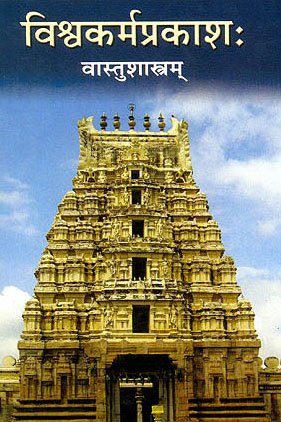
Vastushastra (वास्तुशास्त्र, vāstuśāstra) refers to the ancient Indian science (shastra) of architecture (vastu), dealing with topics such architecture, sculpture, town-building, fort building and various other constructions. Vastu also deals with the philosophy of the architectural relation with the cosmic universe.
Purana and Itihasa (epic history)
Source: Wisdom Library: Skanda-puranaCaturmukha (चतुर्मुख) is the name of a gaṇa (attendant of Śiva), mentioned in the Skandapurāṇa 4.2.53. In this chapter, Śiva (Giriśa) summons his attendants (gaṇas) and ask them to venture towards the city Vārāṇasī (Kāśī) in order to find out what the yoginīs, the sun-god, Vidhi (Brahmā) were doing there.
While the gaṇas such as Caturmukha were staying at Kāśī, they were desirous but unable of finding a weakness in king Divodaśa who was ruling there. Kāśī is described as a fascinating place beyond the range of Giriśa’s vision, and as a place where yoginīs become ayoginīs, after having come in contact with it. Kāśī is described as having both the power to destroy great delusion, as well as creating it.
The Skandapurāṇa narrates the details and legends surrounding numerous holy pilgrimages (tīrtha-māhātmya) throughout India. It is the largest Mahāpurāṇa composed of over 81,000 metrical verses, with the core text dating from the before the 4th-century CE.
Source: archive.org: Shiva Purana - English TranslationCaturmukha (चतुर्मुख) refers to the “four-faced deity”, and is used to describe Śiva assuming the form of Brahmā, according to the Śivapurāṇa 2.3.30 (“The Celebration of Pārvatī’s Return”).—Accordingly, as Brahmā narrated to Nārada: “[...] In the meantime the lord of mountains returned from the Gaṅgā. He saw the mendicant in the human form in his court-yard. [...] Then the lord of mountains saw the four-faced deity (caturmukha), the creator of worlds, red in colour and reciting the Vedic hymns. Then the lord of mountains saw the form of the sun, the eye of the universe, much to his enthusiastic amazement. Then, O dear one, he saw him in the wonderful form of Śiva accompanied by Pārvatī. He was smiling and shining beautifully. [...]”.
Source: Cologne Digital Sanskrit Dictionaries: The Purana IndexCaturmukha (चतुर्मुख).—Brahmā (s.v.) as Vedarāśī with Gāyatri and Sāvitri; acted as Udgāta for Soma's Rājasūya and officiated as priest for Umā's marriage;1 three avastas of: as Brahmā, Kāla and Puruṣa, creating, destroying and as being indifferent; hence three guṇas, three agnis, three Vedas and three worlds.2
Source: JatLand: List of Mahabharata people and placesCaturmukha (चतुर्मुख) is a name mentioned in the Mahābhārata (cf. XIV.8.30, XIV.8) and represents one of the many proper names used for people and places. Note: The Mahābhārata (mentioning Caturmukha) is a Sanskrit epic poem consisting of 100,000 ślokas (metrical verses) and is over 2000 years old.

The Purana (पुराण, purāṇas) refers to Sanskrit literature preserving ancient India’s vast cultural history, including historical legends, religious ceremonies, various arts and sciences. The eighteen mahapuranas total over 400,000 shlokas (metrical couplets) and date to at least several centuries BCE.
Shaivism (Shaiva philosophy)
Source: Shodhganga: Iconographical representations of ŚivaCaturmukha (चतुर्मुख) or Caturmukhāgama refers to one of upāgamas (supplementary scriptures) of the Bimbāgama which is one of the twenty-eight Siddhāntāgama: a classification of the Śaiva division of Śaivāgamas. The Śaivāgamas represent the wisdom that has come down from lord Śiva, received by Pārvatī and accepted by Viṣṇu. The purpose of revealing upāgamas (e.g., Caturmukha Āgama) is to explain more elaborately than that of mūlāgamas (e.g., Bimba-āgama) and to include any new idea if not dealt in mūlāgamas.
Source: SOAS University of London: Protective Rites in the Netra TantraCaturmukha (चतुर्मुख) refers to “four faces” and is used to describe Brahmā, according to the Netratantra of Kṣemarāja: a Śaiva text from the 9th century in which Śiva (Bhairava) teaches Pārvatī topics such as metaphysics, cosmology, and soteriology.—Accordingly, [verse 13.29-36, while describing the appearance and worship of Rudra]—“The auspicious Brahmā [has] four faces (caturmukha), four arms, beautiful eyes, and a red complexion. [He holds] a bundle of very sharp grass [that] hangs down [from his hands]. [Brahmā is] mounted on Haṃsa, holds a stick and rudrākṣa, carries a water jar for protection, [and] the four Vedas. [He] gives the fruits of all siddhis”.

Shaiva (शैव, śaiva) or Shaivism (śaivism) represents a tradition of Hinduism worshiping Shiva as the supreme being. Closely related to Shaktism, Shaiva literature includes a range of scriptures, including Tantras, while the root of this tradition may be traced back to the ancient Vedas.
Kavya (poetry)
Source: Google Books: Indian Kāvya LiteratureCaturmukha (Apabhraṃśa Caumuha=nominative Caumuhu), we see that he was one of the greatest Apabhraṃśa epic poets, though known at present only from a few quotations and references. Though a Brahmanical author, he receives homage from Jaina poets, who indicate also that he was the pioneer of the ‘classical’ form of Apabhraṃśa epic, which moreover became the classical form of epic continued in later languages such as Avadhī. Thus Svayambhū (Riṭṭhaṇemicariu 1.1.10) says that Caumuhu ‘made over to him’ the paddhaḍiā (metre) ‘entwined with’ the chaḍḍaṇi, duvai and dhuvau.
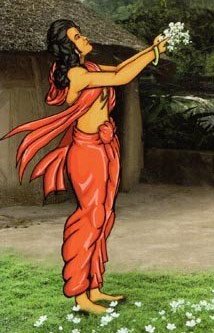
Kavya (काव्य, kavya) refers to Sanskrit poetry, a popular ancient Indian tradition of literature. There have been many Sanskrit poets over the ages, hailing from ancient India and beyond. This topic includes mahakavya, or ‘epic poetry’ and natya, or ‘dramatic poetry’.
Pancaratra (worship of Nārāyaṇa)
Source: eScholarship: Chapters 1-14 of the Hayasirsa PancaratraCaturmukha (चतुर्मुख) refers to “four-faced one” and is a name of Brahmā, as mentioned in the 9th century Hayaśīrṣa-pañcarātra (Ādikāṇḍa chapter 1).—“[...] Formerly, it is told, Virūpākṣa-Maheśvara (i.e., Śiva) with Gaurī (i.e., Pārvatī) questioned the four-faced one (Caturmukha, i.e., Brahmā) who was staying in the above of Vairāja”.
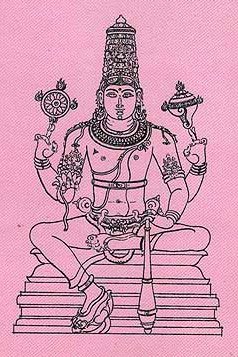
Pancaratra (पाञ्चरात्र, pāñcarātra) represents a tradition of Hinduism where Narayana is revered and worshipped. Closeley related to Vaishnavism, the Pancaratra literature includes various Agamas and tantras incorporating many Vaishnava philosophies.
Ayurveda (science of life)
Dietetics and Culinary Art (such as household cooking)
Source: Shodhganga: Dietetics and culinary art in ancient and medieval IndiaCaturmukha (चतुर्मुख) is another name for Mudgānna or “rice cooked with green gram” and represents one of the six kinds of “cooked rice” (bhakta) as described in the 17th century Bhojanakutūhala (dravyaguṇāguṇa-kathana), and is commonly found in literature dealing with the topics of dietetics and culinary art, also known as Pākaśāstra or Pākakalā.—[...] Cooked rice dishes are of six types based upon the different ingredients used along with rice. These, collectively called as ṣaḍvidhānna. They are [viz., mudgānna (rice cooked with green gram)]. To describe this ṣaḍvidhānna the author quotes an Ayurvedic text namely Kriyāsāra.

Āyurveda (आयुर्वेद, ayurveda) is a branch of Indian science dealing with medicine, herbalism, taxology, anatomy, surgery, alchemy and related topics. Traditional practice of Āyurveda in ancient India dates back to at least the first millenium BC. Literature is commonly written in Sanskrit using various poetic metres.
Shaktism (Shakta philosophy)
Source: Google Books: ManthanabhairavatantramCaturmukhā (चतुर्मुखा) refers to “one having four faces”, according to the Manthānabhairavatantra, a vast sprawling work that belongs to a corpus of Tantric texts concerned with the worship of the goddess Kubjikā.—Accordingly, “(Kāmahā) the Maṅgalā from Kāmarūpa has four faces [i.e., caturmukhā] and is very powerful. She has two arms and sits on a ghost. She makes gestures of fearlessness and boon bestowal; she is well adorned with all the ornaments and has a large, pleasing and auspicious face”.

Shakta (शाक्त, śākta) or Shaktism (śāktism) represents a tradition of Hinduism where the Goddess (Devi) is revered and worshipped. Shakta literature includes a range of scriptures, including various Agamas and Tantras, although its roots may be traced back to the Vedas.
In Buddhism
Tibetan Buddhism (Vajrayana or tantric Buddhism)
Source: Brill: Śaivism and the Tantric Traditions (tantric Buddhism)Caturmukha (चतुर्मुख) refers to “four-faced” and is used to describe Mahāvairocana, according to the Nāmamantrārthāvalokinī by Vilāsavajra, which is a commentary on the Nāmasaṃgīti.—Accordingly, [while describing Mahāvairocana]—“And then [the Sādhaka should visualise] Mahāvairocana on the principal seat, generated by means of the syllable āḥ. [Why has he four faces?] Since consciousness—which is of the nature of the Dharma-Sphere since, by its nature, it lacks such forms as the grasped [i.e., the subject-object duality]—is four-faced (caturmukha). [This is] because the four liberation faces [/doors]—emptiness and the rest—are the cause of the origination of all meditative concentrations, [and this in turn is] because their ground is the Dharma-Sphere. [...]”.

Tibetan Buddhism includes schools such as Nyingma, Kadampa, Kagyu and Gelug. Their primary canon of literature is divided in two broad categories: The Kangyur, which consists of Buddha’s words, and the Tengyur, which includes commentaries from various sources. Esotericism and tantra techniques (vajrayāna) are collected indepently.
In Jainism
General definition (in Jainism)
Source: archive.org: The Jaina IconographyCaturmukha (चतुर्मुख) or Ṣaṇmukha is the name of the Yakṣa accompanying Vimalanātha: the thirteenth of twenty-four Tīrthaṃkaras or Jinas, commonly depicted in Jaina iconography.—Jaina liturgical treatises attribute to Vimalanātha, the thirteenth Jina, the Lāñchana or symbol of the boar. The particular attendant spirits attached to him are named as Ṣaṇmukha and Vairoṭi (Śvetāmbara: Viditā). The King to stand for his fanner is called Svayaṃbhu-Vāsudeva. His Kevala tree is Jambu (Black-berry).
Ṣaṇmukha is known by the name of Caturmukha, to the Digambaras and Ṣaṇmukha to the Śvetāmbaras. Both sects, however, concurrenily assign to him the vehicle of a peacock. Caturmukha has twelve arms acem ding to one version and eight arms according to another. The arms hold such objects as—an axe, scimitar (Kaukṣeyaka), Akṣamaṇi (?) shield, staff etc. The Yakṣa Ṣaṇmukha has twelve hands holding a fruit, disc, arrow, sword, noose, rosary, mongoose, discus, bond, fruit, goad and Abhaya.
Source: archive.org: TrisastisalakapurusacaritraCāturmukha (चातुर्मुख) is the name of an ancient king, according to the Jain Ramayana and chapter 7.4 [Rāma and Lakṣmaṇa] of Hemacandra’s 11th century Triṣaṣṭiśalākāpuruṣacaritra: an ancient Sanskrit epic poem narrating the history and legends of sixty-three illustrious persons in Jainism.—Accordingly, “Siṃharatha’s son, Brahmaratha, became king next, then Cāturmukha, Hemaratha, Śataratha, Udayapṛthu, Vāriratha, Induratha, Ādityaratha, Māndhātṛ, Vīrasena in turn, King Pratimanyu, King Pratibandhu, King Ravimanyu, Vasantatilaka, Kuberadatta, Kunthu, Śarabha, Dvirada in turn, then Siṃhadaśana, Hiraṇyakaśipu, Puñjasthala, Kakutstha, Raghu. Among these kings some reached emancipation and some heaven”.

Jainism is an Indian religion of Dharma whose doctrine revolves around harmlessness (ahimsa) towards every living being. The two major branches (Digambara and Svetambara) of Jainism stimulate self-control (or, shramana, ‘self-reliance’) and spiritual development through a path of peace for the soul to progess to the ultimate goal.
Languages of India and abroad
Sanskrit dictionary
Source: DDSA: The practical Sanskrit-English dictionaryCaturmukha (चतुर्मुख).—an epithet of Brahmā; इतरतापशतानि यथेच्छया वितर तानि सहे चतुरानन (itaratāpaśatāni yathecchayā vitara tāni sahe caturānana) Udb.
Derivable forms: caturmukhaḥ (चतुर्मुखः).
Caturmukha is a Sanskrit compound consisting of the terms catur and mukha (मुख). See also (synonyms): caturānana.
--- OR ---
Caturmukha (चतुर्मुख).—having four faces.
-khaḥ an epithet of Brahmā; त्वत्तः सर्वं चतु- र्मुखात् (tvattaḥ sarvaṃ catu- rmukhāt) R.1.22. (-kham) 1. four faces; Kumārasambhava 2.17.
Caturmukha is a Sanskrit compound consisting of the terms catur and mukha (मुख).
Source: Cologne Digital Sanskrit Dictionaries: Shabda-Sagara Sanskrit-English DictionaryCaturmukha (चतुर्मुख).—m.
(-khaḥ) 1. The deity Brahma. 2. A preparation of mercury. E. catur and mukha a face.
Source: Cologne Digital Sanskrit Dictionaries: Benfey Sanskrit-English DictionaryCaturmukha (चतुर्मुख).—(n.) I. four faces, [Kumārasaṃbhava, (ed. Stenzler.)] 2, 17. Ii. adj. 1. having four faces, epithet of Brahman, [Rāmāyaṇa] 1, 2, 26; Viṣṇu, [Raghuvaṃśa, (ed. Stenzler.)] 10, 23; Śiva, [Sundopasundopākhyāna] 3, 28; and a Dānava, [Harivaṃśa, (ed. Calc.)] 12934. 2. having four points, [Harivaṃśa, (ed. Calc.)] 10630. Jaya
Caturmukha is a Sanskrit compound consisting of the terms catur and mukha (मुख).
Source: Cologne Digital Sanskrit Dictionaries: Cappeller Sanskrit-English DictionaryCaturmukha (चतुर्मुख).—(°—) four faces; [adjective] four-faced, [masculine] [Epithet] of [several] gods.
Source: Cologne Digital Sanskrit Dictionaries: Monier-Williams Sanskrit-English Dictionary1) Caturmukha (चतुर्मुख):—[=catur-mukha] [from catur > catasṛ] (in [compound]) 4 faces, [Kumāra-sambhava ii, 17]
2) [v.s. ...] mfn. ‘four-faced’, in [compound]
3) [v.s. ...] four-pointed (an arrow), [Harivaṃśa 10630]
4) [v.s. ...] m. Name of Brahmā, [Mahābhārata iii; Rāmāyaṇa i; Bhāgavata-purāṇa iii, 8, 16; Kathāsaritsāgara xx]
5) [v.s. ...] of Viṣṇu, [Harivaṃśa 12344; Raghuvaṃśa x, 23]
6) [v.s. ...] of Śiva (cf. -tva), [Mahābhārata xiii, 6393]
7) [v.s. ...] of a Dānava, [Harivaṃśa 12934]
8) [v.s. ...] (in music) a kind of measure
Source: Cologne Digital Sanskrit Dictionaries: Yates Sanskrit-English DictionaryCaturmukha (चतुर्मुख):—[catur-mukha] (khaḥ) 1. m. The deity Brahmā; a preparation of mercury.
Source: DDSA: Paia-sadda-mahannavo; a comprehensive Prakrit Hindi dictionary (S)Caturmukha (चतुर्मुख) in the Sanskrit language is related to the Prakrit word: Caummuha.
[Sanskrit to German]
Sanskrit, also spelled संस्कृतम् (saṃskṛtam), is an ancient language of India commonly seen as the grandmother of the Indo-European language family (even English!). Closely allied with Prakrit and Pali, Sanskrit is more exhaustive in both grammar and terms and has the most extensive collection of literature in the world, greatly surpassing its sister-languages Greek and Latin.
Kannada-English dictionary
Source: Alar: Kannada-English corpusCaturmukha (ಚತುರ್ಮುಖ):—
1) [noun] Brahma, the Creator of the universe, who is conceived as having four faces.
2) [noun] a man characterised by cleverness and wit.
3) [noun] (jain.).
Kannada is a Dravidian language (as opposed to the Indo-European language family) mainly spoken in the southwestern region of India.
See also (Relevant definitions)
Partial matches: Mukha, Catur.
Starts with: Caturmukha-bimba, Caturmukhalinga, Caturmukharasa, Caturmukhatirtha, Caturmukhatva.
Ends with: Cintamanicaturmukha.
Full-text (+17): Caturvaktra, Caturmukhatirtha, Caturmukharasa, Caturmukhatva, Kandarpa, Cintamanicaturmukha, Caturmukha-bimba, Caummuha, Bhamandala, Caumukha, Caturanana, Brahma, Vairaja, Pancamukha, Caturmukan, Mudganna, Nigudha, Nanmukan, Shanmukha, Chaillu.
Relevant text
Search found 38 books and stories containing Caturmukha, Catur-mukha, Caturmukhā, Catur-mukhā; (plurals include: Caturmukhas, mukhas, Caturmukhās, mukhās). You can also click to the full overview containing English textual excerpts. Below are direct links for the most relevant articles:
Lord Hayagriva in Sanskrit Literature (by Anindita Adhikari)
Central Myth (5): Birth of Brahmā < [Chapter 3]
Chaitanya Bhagavata (by Bhumipati Dāsa)
Verse 1.8.100 < [Chapter 8 - The Disappearance of Jagannātha Miśra]
Verse 2.14.2 < [Chapter 14 - Yamarāja’s Saṅkīrtana]
Verse 2.13.377 < [Chapter 13 - The Deliverance of Jagāi and Mādhāi]
Kashyapa Shilpa-shastra (study) (by K. Vidyuta)
7. The Shapes and Embellishments of the Gopuras < [Chapter 5 - Gopura Lakṣaṇa]
Brihad Bhagavatamrita (commentary) (by Śrī Śrīmad Bhaktivedānta Nārāyana Gosvāmī Mahārāja)
Verse 2.2.142 < [Chapter 2 - Jñāna (knowledge)]
Verse 1.7.2 < [Chapter 7 - Pūrṇa (pinnacle of excellent devotees)]
Verse 2.4.142-144 < [Chapter 4 - Vaikuṇṭha (the spiritual world)]
Brahma Sutras (Ramanuja) (by George Thibaut)
Sutra 1.3.12 < [First Adhyaya, Third Pada]
Nor do Smriti and Purana teach such a doctrine < [First Adhyaya, First Pada]
The Skanda Purana (by G. V. Tagare)
Chapter 309 - Greatness of Four-Faced Vināyaka < [Section 1 - Prabhāsa-kṣetra-māhātmya]
Chapter 310 - Greatness of Kalaṃbeśvara (Kalaṃba-īśvara) < [Section 1 - Prabhāsa-kṣetra-māhātmya]
Chapter 55 - Ganeśa Proceeds on a Mission to Kāśī < [Section 2 - Uttarārdha]
Related products
